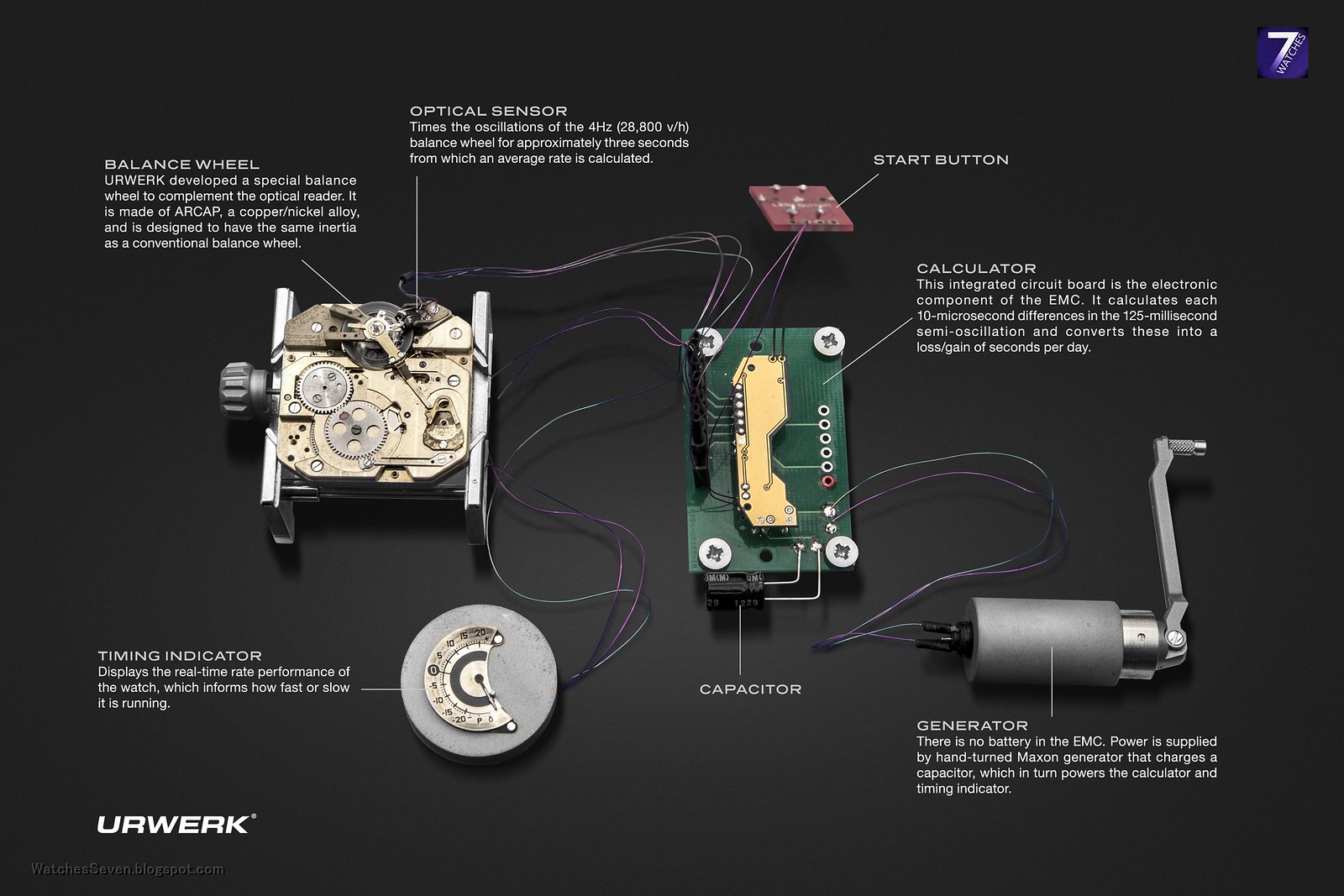URWERK – EMC TimeHunter X-Ray Limited Edition NEW
URWERK introduces the TimeHunter X-Ray
Geneva, September 7, 2016.
The unorthodox EMC TimeHunter is a watch in the subversive URWERK tradition. This unique concept combines a precision mechanical movement with an electronic module that monitors its rate. Simply by pressing a button you discover whether your watch is running fast or slow and the amplitude of its balance. Furthermore, you can adjust it accordingly for optimum timekeeping.The EMC concept, introduced in 2013, has won watchmaking’s most prestigious awards, but how well do you know the EMC TimeHunter? Can you describe its inner workings or the play of wheels and pinions that ensure its chronometric performance? To give you an idea, URWERK presents the TimeHunter X-Ray, a limited edition of 15 watches that delivers a conceptual and stylistic knockout.
Click on the mouse wheel to see the large size ... BIG FOTO
“We have perfected one of the most reliable way of regulating a 100% mechanical watch by making mechanics intelligent,” explains watchmaker Felix Baumgartner, co-founder of URWERK. The intelligence comes from the interactive dialogue that links the watch to its owner. “In the EMC TimeHunter we have conceived and developed a purposefully accurate movement with an unusual balance-wheel and twin mainspring barrels for a constant power output,” he adds. “We then grafted on to this mechanism an electric monitor that tells the owner how his watch is performing. With this information, he can effectively control his EMC, adjusting it to the second. Our EMC TimeHunter relies on the mechanical movement that we have designed and built in our workshops; the function of the electronic module is to challenge its performance in real time and provide the most accurate information possible.”
Click on the mouse wheel to see the large size ... BIG FOTO
The TimeHunter X-Ray comes across as a timepiece that is easy to read with a central dial for black hours and minutes hands coated with white SuperLuminova for enhanced contrast. A rotating disc showing the seconds at 1 o'clock is balanced at 7 o'clock by a power-reserve indicator.
Click on the mouse wheel to see the large size ... BIG FOTO
The EMC TimeHunter’s performance indicator showing its rate (± 15 seconds a day) and balance amplitude on demand are at 10 o'clock. On the back of the watch the movement can be seen through the sapphire crystal. Also on the back is the rate-adjustment screw, one of the nerve centres of this watch. For Martin Frei, co-founder and artistic director of URWERK “the back of the watch reveals two opposing worlds sharing the same case: electronic circuits and the finest mechanical movement. They invite you to find out more — specifically how this unusual timepiece works. The same goes for the face of the watch, for the TimeHunter X-Ray as its name says it, hides nothing. The mechanism, wheel-train, electronic circuits, indeed all the secret operations of the watch are displayed for its owner.”
Click on the mouse wheel to see the large size ... BIG FOTO
What are the EMC TimeHunter’s benefits for its owner?
“If it’s not properly adjusted, even the most expensive movement remains a useless mechanism.” This is the premise on which the URWERK team got to work on the EMC TimeHunter.
The rate of a mechanical watch depends on its position in space as well as its temperature. Before selling a precision watch, therefore, the manufacturer usually tests it by placing it on a continuously rotating arm in a room where the temperature is relatively stable. The watch thus spends the same amount of time in each position. However, in real conditions, the time spent in each position varies according to the working or leisure activities of its owner and for how long the watch is actually on the wrist. Thus two identical watches with different owners might show a different weekly gain or loss.
Click on the mouse wheel to see the large size ... BIG FOTO
Simply by pressing a button the owner of an EMC TimeHunter watch can find out the rate of his watch — how much it is gaining or losing. He can then adjust it accordingly. This interactive feature enables the owner to adapt his watch to his lifestyle and the changing environment.
Click on the mouse wheel to see the large size ... BIG FOTO
How it works
The energy for the electronic rating module is generated by turning a crank. When the button is pressed, a hand points to one of two symbols: δ (the rate is being measured) or P (insufficient energy). If the measurement is possible the hand first points to the rate — ± 15 seconds a day — and then, after a short pause, the amplitude of the balance. In addition, a light emitting diode shows green if the watch is performing correctly and red if the rate is outside acceptable tolerances.
What is amplitude and how is it measured by the EMC TimeHunter?
Click on the mouse wheel to see the large size ... BIG FOTO
While the rate of a watch — its daily gain or loss — can be easily understood, the amplitude of its balance is less obvious. This measures in degrees of arc the swing of a pendulum in a clock or of an oscillating balance wheel in a watch.
In theory, each oscillation of a pendulum or a balance must be isochronous. That is to say that it must be of exactly the same duration, irrespective of its amplitude. In most mechanical watches, an amplitude of between 240° and 310° ensures optimal performance. Since the tiny balance wheel of a watch weighs so little and swings so quickly at four oscillations a second, its amplitude can be affected by a variety of factors. For example, if the balance staff is insufficiently lubricated it will lose amplitude. The amplitude is thus a valuable indicator of whether the watch needs servicing.
The balance is the beating heart of every mechanical watch. Like a human heart, its rhythm (isochronism) and pulse (amplitude) show the state of its health.
What can be seen at the back of the watch?
Click on the mouse wheel to see the large size ... BIG FOTO
Apart from the sophisticated finish of the movement, the key features of the back of the EMC TimeHunter are the adjustment screw and the push-button at the bottom of the dial between the lugs that releases the winding crown. Noticeable in the movement is the cover of the twin barrels that houses the optical sensors measuring the oscillations. The sensors are linked by a tiny cable to the electronic components to its right, which can be seen behind a lattice. Next to the integrated circuit board can be seen the stacked twin barrels.
For URWERK, the crazy idea of incorporating a workbench instrument within a watch represented the ultimate challenge. “Simply by pressing a button you get accurate and reliable information on the timekeeping status of your EMC TimeHunter, hitherto only available from a professional,”Felix Baumgartner explains. “Thanks to this system, you can safely interact with one of the most exhilarating mechanisms invented by man — the mechanical watch.”
Click on the mouse wheel to see the large size ... BIG FOTO
Click on the mouse wheel to see the large size ... BIG FOTO
The EMC TimeHunter can be described as a precise mechanical watch with a proprietary movement designed, developed and manufactured in URWERK’s Zurich workshops and adjusted by URWERK in Geneva. Its movement complies with the highest quality standards. Its timekeeping functions are adjusted in five positions during a 30-day test to reach chronometer standards.
Click on the mouse wheel to see the large size ... BIG FOTO
The EMC TimeHunter movement has the following features:
- Its balance wheel is made of ARCAP, an alloy chosen by URWERK for its non-magnetic and anti-corrosive qualities. Its unusual shape has been scientifically calculated to be aerodynamic and minimise the effects of air friction and to achieve an optimal amplitude.
- Its twin mainsprings are housed in two superimposed barrels to ensure a constant power supply and a power reserve of 80 hours.
- Its exterior adjustment screw, connected to the fast/slow index on the balance, enables the rate to be adjusted by changing the effective length of the balance spring.
To monitor the rate and amplitude of the balance an electronic brain had to be perfected. Olivier Evalet, software developer and electronic engineer was heavily involved in the project. “Our idea was to use optics or the properties of light to measure the rate of a mechanical movement to within less than a microsecond. The system we came up with was designed to be long lasting. The energy to power the brain of the EMC TimeHunter doesn’t come from an ordinary battery but from a capacitor that can be recharged between 100,000 and 200,000 times with very little loss of its efficiency. We have also selected an resonator with an extremely long life that varies by just three parts in a million over a year.”
Click on the mouse wheel to see the large size ... BIG FOTO
The EMC TimeHunter’s monitoring device has the following characteristics:
- An optical sensor of the balance wheel, which times each vibration (semi-oscillation) of the 28,800 v/h (4Hz) balance for three seconds. The sensor consists of a light source and a receiver on either side of the balance wheel. Pressing a button on the left of the watchcase activates the measurement.
- A 16 million Hz quartz resonator constitutes the frequency reference of the EMC TimeHunter. The 4 Hz frequency of the mechanical balance is compared to that of the resonator to obtain the most precise measurement possible.
- A smart electronic chip calculates the difference (δ) between the rate of the balance and that of the reference resonator. Each microsecond of difference corresponds to a gain or loss of a second a day in the rate of the movement. Thus a variation of 0.0000014 seconds in each vibration translates into a gain or loss of one second a day.
- A hand-cranked generator. The power for the optical sensor and electronic calculator of the EMC TimeHunter is derived from a generator made by the Swiss Maxon firm, which developed the motors for the Nasa Mars expedition.
The TimeHunter X-Ray confirms the advent of the mechanical watch enhanced by electronic functions that provide a diagnosis of its timekeeping performance. Such a watch gives its owner the active role of getting the best performance from his timepiece.
---------------------------------------------------
Technical Specifications
EMC TimeHunter X-Ray
Limited Editions of 15 pieces
Case
Case material: Grade 5 titanium and steel with black PVD treatmentDimensions: Width 43 mm, length 51 mm, height 15.8 mm
Glasses: Sapphire crystal with anti-reflective coating
Water resistance: Pressure tested to 30 m/ 3 ATM
Finishing: Brushed and shot peened
Movement
Calibre: UR-EMC designed and manufactured by URWERK
Escapement: Swiss lever escapement
Balance wheel: ARCAP P40, linear balance coupled to the optical sensor
Frequency: 28,800 vph - 4Hz
Balance spring: Flat
Power source: Stacked double mainspring barrels coupled in series
Power reserve: 80 hours
Winding: Manual winding
Surface finishes: Openworked baseplate, Geneva stripes, snailing, sand blasting,
Chamfered screw heads
Artificial intelligence Generator: Maxon® hand-cranked generator to charge a capacitor
EMC system: Optical sensor controlled by an integrated circuit board; 16'000'000hz reference oscillator
Indications
Hours, minutes, seconds, rate indicator δ, amplitude, power reserve,
Index adjustment screw
Controls
Two-position crown
Winding handle to generate electricity to power the δ precision indicator
Button to activate the δ precision and amplitude indicators
On the back: Crown release button and Fine-tuning screw to adjust the rate
---------------------------------------
Press Release - 2016
--------------------------------------------
Media contact:
Ms Yacine Sar
Telephone: +41 22 900 2027
Mobile : +41 79 834 46 65
press@urwerk.com
------------------------------------------------
www.facebook.com - URWERK
------------------------------------------------------
www.Urwerk.com



















